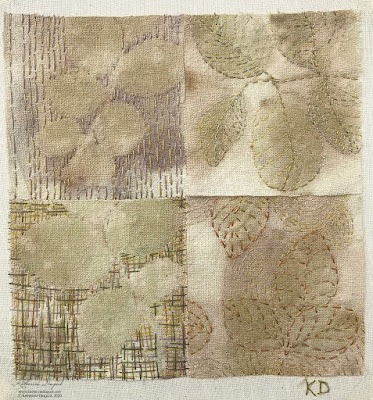Week 1 with Sue Stone: Pick 1 stitch and explore it in 4 squares.
I have admired and followed Sue Stone's work for years and would love to take a workshop with her at some point. I love her focus on exploration of simple stitches used in very effective ways to render and create texture. For her Week 1 Challenge, she suggested that we pick 1 stitch and explore it in 4 squares. I picked Running Stitch as I feel it is the most amazingly versatile stitch.
I began my Running Stitch Sampler by cutting 4 squares from some old eco-print off cuts. These bits are from a batch of eco-prints using rose leaves on raw silk that I did while teaching at Arrowmont in 2017. I wanted to take 2 squares and explore stitching the negative space of the rose leaves and explore stitching the positive space in the other 2 squares. I also wanted to play with color mixing using colors that complemented the eco-prints and for the most part were of a similar value to the fabric.
Week 2 with Cas Holmes: Create a fiber collage.
Cas Holmes' work combines drawing, watercolor, hand stitch, free motion embroidery, and appliqué to create beautiful fiber collages. For her Week 2 Challenge, she suggested that we look at objects that are currently around us and blend that with the exploration and memories of place.
With this collage, I wanted to challenge myself to again incorporate bits of my eco-print off cuts and I also wanted to challenge myself to get my watercolors out and experiment with them. I have to admit that I had forgotten how much I love to use watercolor! The collage part was daunting to me, partly because I could not decide if I wanted a formal composition or something that felt less formal and more sketchbook-like. I want to do more of this as I found that as I stitched I wanted to be looser with the composition.
The green glass is one that has sat on my desk for years. I love green glass and collect it and this is part of a set I found at a Goodwill years ago. I have watercolored it on just normal mixed media sketchbook paper. It was interesting stitching the paper onto the fabric and thinking about the stitch placement on the watercolor. The weed is one that I pressed last summer that I found in a parking lot. It is layered with a bit of Chantilly lace that I had that had a floral pattern that was a similar shape to the pressed flower.
The clover was another old eco-printed bit. I had hammered it into the linen a couple years ago and did a bit of whitework into the negative space. The other bits are bits of eco-prints of rose leaves on raw silk and Appalachian ragwort on silk charmeuse.
Emily Tull is a textile artist in the UK and you should check out her needle painted portraits. I love her play with negative and positive space and her choices of which areas to embroider.
For Week 3, Emily challenged us to stitch an eye-- that statement sounds so simple. So, I must admit when I first watched her challenge video, I was a bit daunted by it. I started back in my sketchbooks before I stitched anything-- I needed a bit of time. I looked through old photographs and sketched some eyes and then my kids graciously and enthusiastically modeled different poses. (My daughter got so into this that I found about 50 selfies of her eyeball on my phone shortly after this-- I will readily admit their excitement was contagious.) After sketching, I moved to a bit of colored pencil and then to watercolor. The watercolor was really interesting as it satisfied my love of color with intense study of these eyes and provided the extra bit of courage I needed to jump in with my needle.
For the first eye I stitched, I chose to use an acid green and 2 purples. I originally made this decision because I wanted to play with color. Looking back now, I think it actually gave me a bit of distance from the pressure of making the eye look too realistic. After that pair of eyes was finished, I just kept stitching more and more eyes. I stitched some eyes with just 1 color, some with just 2, some with just 3 and some with as many colors as I felt necessary. I stitched the same pair of eyes in a single color three different times to see how just that change of color affected the emotion of the eyes. I stitched some in 1 strand and some with 2 strands. I wanted to explore how much I needed to stitch to communicate an eye and how much I could stitch to make it feel more realistic. With each eye, I posed a separate question to myself to address. I may go back and add some more eyes to this, but for now, I'm calling it finished.
A note about the ground fabric of my Eye Sampler: These are all bits of different eco-print off cuts that I appliquéd to a cotton muslin base. There is some raw silk, silk charmeuse, silk matka, silk dupioni, and linen. I worked this piece all in hand (no hoop) to allow the natural hand tension to add more texture.
A note about the threads: The threads are mostly Weeks Dye Works and Valdani cotton floss but I also stitched a little using Valdani's sewing thread 35wt. There is no black on this piece. I wanted the added challenge of using color mixing and color theory principles (value and complementary colors) to create the contrast needed to render these eyes.
Now back to my studio to stitch Week 4 with Richard McVetis.







